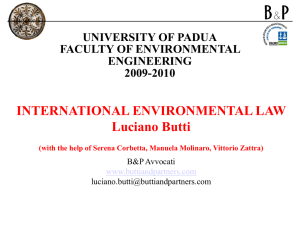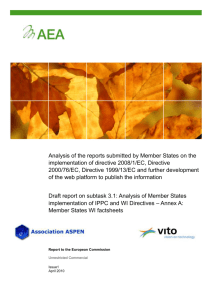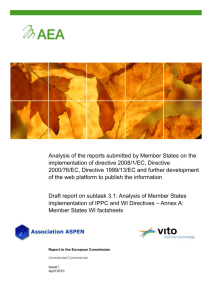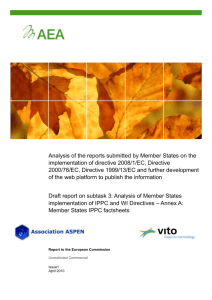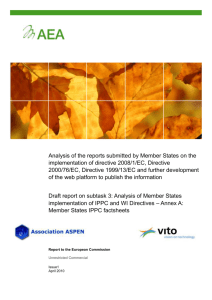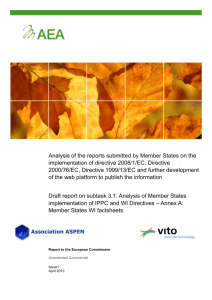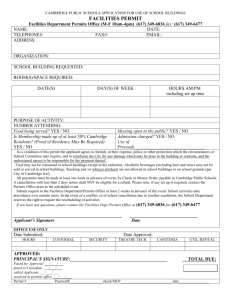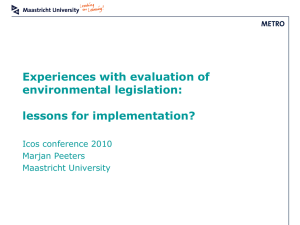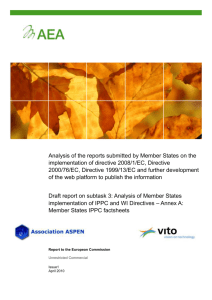MS factsheets IPPC EE
advertisement
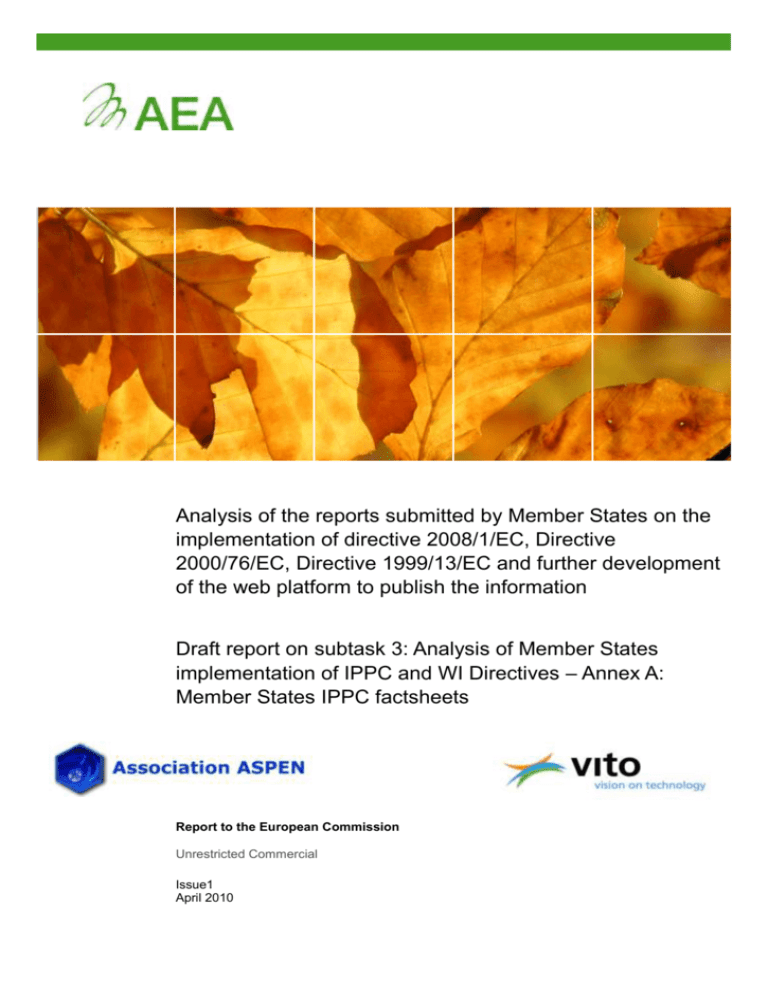
Analysis of the reports submitted by Member States on the implementation of directive 2008/1/EC, Directive 2000/76/EC, Directive 1999/13/EC and further development of the web platform to publish the information Draft report on subtask 3: Analysis of Member States implementation of IPPC and WI Directives – Annex A: Member States IPPC factsheets Report to the European Commission Unrestricted Commercial Issue1 April 2010 Unrestricted Analysis of the reports submitted by the Member States Framework contract No. ENV/C.4/FRA/2007/0011 Draft Report Title Analysis of the reports submitted by the Member States and the further development of the web platform to publish the information Customer European Commission Customer reference ANV.C.4/FRA/2007/0011 Confidentiality, copyright and reproduction Unrestricted File reference Reference number Marie Leverton AEA Gemini Building Harwell IBC Didcot OX110QR UK t: 0870 190 2817 f: 0870 190 5545 AEA is a business name of AEA Technology plc AEA is certificated to ISO9001 and ISO14001 Author Name Approved by Name Liesbet Goovaerts (VITO) Katrijn Alaerts (VITO Ive Vanderreydt (VITO) Signature Date AEA Energy & Environment iii Unrestricted Analysis of the reports submitted by the Member States Framework contract No. ENV/C.4/FRA/2007/0011 Draft Report Table of contents Annex A iv 5 AEA Unrestricted Analysis of the reports submitted by the Member States Framework contract No. ENV/C.4/FRA/2007/0011 Draft Report Annex A Annex A sets out the detailed overviews of the Member States responses to the questionnaire. For each Member State a individual fact sheet is drafted containing: - The main text given in the response to each qualitative question by means of a short summary. This short summary presents the most relevant information provided by the MS in relation to each question. The responses of the Member States are compared with the data given in the previous reporting exercise, to see whether important changes have been made during this reporting period. The questions are structured using the 5 main categories, used in the reporting tool. The qualitative questions are further split into subcategories providing an overview of specific practical approach and experiences of the Member States for each of the main categories. - Presentation of the Member States quantitative data in tables; - The completeness table, which indicates the degree to which the answers comply with the requirements of the questionnaire. The method described in the main report is used; - A summary on the status of implementation. This summary describes whether or not all requirements are implemented into a functional and effective practical systems. In particular the recent progress since the previous reporting made by the MS is assessed and the implementation issues solved are enlightened. These fact sheets were presented to the Member States for approval. All comments, clarifications and additional information provided by the Member States were taken into account. These fact sheets are used as the basis for the analysis made in previous chapters. AEA Group 5 Unrestricted Analysis of the reports submitted by the Member States Framework contract No. ENV/C.4/FRA/2007/0011 Draft Report Estonia Overview of the answers The table below presents the detailed analysis of Austria’s responses to each question of the questionnaire, by means of a short summary or standardised answer where appropriate. Comments regarding the adequacy of the answers in relation to the requirements of the questionnaire are added where necessary. AEA Group 6 Unrestricted Analysis of the reports submitted by the Member States Framework contract No. ENV/C.4/FRA/2007/0011 Draft Report Table 1: Estonia – overview of the answers Question number – sub question reporting tool 1 Main category Subcategory: approach or experiences Summary of MS response Comments Question (Q) Category: general description Subcategory: National legislation and legal provisions 1.1 Have any significant changes been made since the last reporting period (2003-2005) to national or sub-national legislation and to the permitting system(s) that implement Directive 2008/1/EC? Yes. Remarks Improved legislation - 14.01.2007 adoption of changes in Integrated Pollution Prevention and Control Act (from 17.10. 2001) for improved harmonisation of the directives 2003/35/EC, 2003/87/EC, 2003/4/EC and 2008/1/EC (on the base of first draft) and practical experience of implementation IPPCD Reference to legislation (2003-2005) AEA Group Regulations of the Minister of Environment: a) from 20.01.2006 no 6 "Requirements, which specify the contents of a permit and standard formats for permits"; b) from 09.02.2006 no 10 "Standard formats of annexes to a permit application and the procedure for completion"; c) from 19.03.2007 no 24 "Confirmation of the formats of the announcements about submitted and received integrated permits applications and issued or refused integrated permits" IPPC Directive was transposed into national legislation by a new legal act: -Integrated Pollution Prevention and Control Act of 2001 (IPPC Act), which was amended by -Administrative Procedure Acts change and implementation Act of July 2002 -Integrated Pollution Prevention and Control Acts amended Act of November 2003 -Environmental Impact Assessment and Environmental Management System Act of Feb 2005 The Act was admitted by 4 regulations of the Ministry of Environment: - Regulation no 77/2002 specifying the contents of a permit and standard formats for permits - Regulation no 68/2002 on permit application contents and specific formats - Regulation no 20/2004 on access to the public through internet concerning permit applications Regulation no 37/2002 on reporting the permit application and 7 Unrestricted Analysis of the reports submitted by the Member States Framework contract No. ENV/C.4/FRA/2007/0011 Draft Report Question number – sub question reporting tool Main category Subcategory: approach or experiences Summary of MS response Comments Question (Q) Level at which legislation apply verifying procurement form of the application Regulation No.150/2002 of the Government of the Republic also enacted on sub-activities and threshold capacities subject to integrated permits and deadlines for operators of existing installations for submitting applications for integrated permits. National. Please describe the changes in 2006-2008 Amendment of existing legislation. Please describe the reasons for these changes Part of an overall revision of the environmental legislative framework. Reference to new legislation or legislative framework See above. 1.3 Describe any legally binding measures or administrative plans established to ensure compliance with the requirements referred to in Article 5(1) by 30 October 2007 1.4 Have operators been obliged to submit, or could competent authorities request from operators the submission of, permit applications for this purpose? National legislation (IPPC Act) requires installations to operate in compliance with requirements of best available techniques at the latest by 30 October 2007. A regulation has been issued in 2002 specifying deadlines for operators of existing installations for submitting applications for integrated permits; the permit applications must be submitted on 1/1/2007 at the latest. Yes. Remarks 1.4.1 If Yes, please explain: 1.5 Describe any changes made since the last reporting period in the organizational structure of the permitting procedures (levels of authorities, distribution of competencies, etc.): Are there changes considering the involved competent authorities? AEA Group Regulation of The Government "Sub-activities and threshold capacities subject to integrated permits and deadlines for the operators of the existing installations submitting and application for an integrated permit" + enforcement activities taken by Environmental Inspection (penalties) No. 8 Unrestricted Analysis of the reports submitted by the Member States Framework contract No. ENV/C.4/FRA/2007/0011 Draft Report Question number – sub question reporting tool Main category Subcategory: approach or experiences Summary of MS response Comments Question (Q) Remarks 1.5.1 If Yes, please explain: 1.6 Are there any particular difficulties in ensuring full co-ordination of the permitting procedure and conditions, especially where more than one competent authority is involved, as required by Article 7? Principle "one authority" works well, no need for any change. No. Remarks 1.6.1 If Yes, please explain: 1.7 Are there any legislation or guidance documents produced on this issue? No. Remarks Solved on the level of IPPC Act. 1.7.1 If Yes, please explain: 1.8 What legal provisions, procedures or guidance are used to ensure that competent authorities refuse to grant a permit in cases where an installation does not comply with the requirements of Directive 2008/1/EC? Have permits been refused so far? 1.9 Set in IPPC Act, in certain case derogations up to 6 months are possible. Yes Remarks AEA Group 9 Unrestricted Analysis of the reports submitted by the Member States Framework contract No. ENV/C.4/FRA/2007/0011 Draft Report Question number – sub question reporting tool Main category Subcategory: approach or experiences Summary of MS response Comments Question (Q) If available, give information on the numbers and circumstances in which permits have been refused (optional): Decrease threshold capacity of an installation, withdraw from area of IPPC regulation. 1.9.1 Total numbers of permits that have been refused within the reporting period 4 1.9.2 Circumstances in which permits have been refused Subcategory: Specific Member States approach Subcategory: Experiences of Member States 1.2 Have Member States experienced any difficulties in implementing the Directive 2008/1/EC associated with the availability and capacity of staff resources? Yes Remarks All difficulties arose because Estonia as the new EU member state had only 5 years for full implementation of IPPCD, instead of 11 years as old member states had. Continuous raise of staff capacity and streamlining of implementation procedure are evergreen needs, as well as awareness of operators. Raise staff capacity. 1.2.1 If yes, Describe these difficulties, for instance illustrated as appropriate by data on current resources. 1.2.2 If yes, Describe any plans to address these difficulties. 2 Category: Permit application and determination process Streamline implementing procedure. Subcategory: National legislation and legal provisions AEA Group 10 Unrestricted Analysis of the reports submitted by the Member States Framework contract No. ENV/C.4/FRA/2007/0011 Draft Report Question number – sub question reporting tool 2.1 Main category Subcategory: approach or experiences Summary of MS response Comments Question (Q) Describe any general binding rules, guidance documents or application forms produced to ensure that applications contain all the information required by Article 6, either generally or in relation to specific issues (e.g. methodology for the assessment of significant emissions from installations). National legislation includes all information required by Article 6 of IPPC Directive on the permit application content. An executive regulation (No 68/2002) standardises the permit application and procedure for completion. 2.2 Describe any general binding rules or specific guidelines for competent authorities that have been issued on the following issues: 2.2.1 the procedures and criteria for setting emission limit values and other permit conditions Set in legislation, no specific guidelines. 2.2.2 the general principles for the determination of best available techniques Principles is set in IPPC Act, more specifically ib subsidiary regulation (see 1.1 a and b). 2.2.3 the implementation of Article 9(4) Set in legislation, no specific guidelines. 2.13 For which categories of installations and which requirements, if any, have general binding rules been established, as provided for by Article 9(8)? (Q 8.1.1) Provide reference to the general binding rules. No general binding rules have been established. 2.14 What form do such rules take (e.g. who establishes them and what legal status do they have)? No general binding rules have been established. Who establishes them? What legal status do they have? Remarks AEA Group 11 Unrestricted Analysis of the reports submitted by the Member States Framework contract No. ENV/C.4/FRA/2007/0011 Draft Report Question number – sub question reporting tool 2.15 Main category Subcategory: approach or experiences Summary of MS response Comments Question (Q) When applying such rules, is provision still made for taking into account the local factors (mentioned in Article 9(4))? No. Remarks 2.16 If known, how many installations (either as an absolute number or a percentage) were subject to these rules by the end of the reporting period? Not provided. 2.18 How do competent authorities decide in practice, under Article 12, whether a “change in operation” may have consequences for the environment (Article 10), and whether such a change is a “substantial change” which may have significant negative effects on human beings or the environment (Article 11)? EIA reports are reviewed, for the case of significant changes in an installation, or for smaller changes, emission limit values are compared with the emissions of the plant. BAT techniques are also used as a basis for comparison. 2.20 Is the frequency of reconsideration and, where necessary, updating of permit conditions (Article 13) specified in national or sub-national law? Yes Remarks Yearly Is there a time limit in the permits? No. 2.21 Remarks 2.22 If determined by other means: What are those other means? Give reference to relevant legislation, guidance or procedures AEA Group The permit authority reviews the permit conditions and performs an on-site inspection at least once a year. Permits can be also updated upon significant changes made in a plant and on the basis of a number of other reasons, described in legislation. 12 Unrestricted Analysis of the reports submitted by the Member States Framework contract No. ENV/C.4/FRA/2007/0011 Draft Report Question number – sub question reporting tool 2.24 2.25 Main category Subcategory: approach or experiences Summary of MS response Comments Question (Q) What does the process of reconsidering and updating permit conditions consist of? How is the provision to reconsider permit conditions in cases of substantial changes in the best available techniques implemented? Give reference to relevant legislation, guidance or procedures The frequency of reconsideration and updating of permit conditions, is specified in national law, according to which, reviews of the permit conditions and an on-site inspection (environmental supervision) are carried out, at least once a year. No experience yet. In general terms this issue is covered by IPPC Act. Subcategory: Specific Member States approach 2.3 How, in general terms, is the information published by the Commission pursuant to Article 17 taken into account generally or in specific cases when determining best available techniques? Generally on training issues and in specific cases of permits application and issuing processes. 2.4 How are the BREFs concretely used for setting permit conditions? Operators use BREFs for their action plan on the introduction of BAT. Competent authority have the rights to set conditions and accept the action plan or propose changes of the plan. 2.5 Are the BREFs (or part of them) translated? No, but reachable through www.envir.ee/ippc in English and summaries in Estonian. It would be regrettable if the BAT chapter as would be translated by Commission in all official EU languages. www.envir.ee/ippc If available, provide a weblink on where these translations can be found 2.8 Have environmental management systems been taken into account in setting permit conditions? Yes. Remarks AEA Group 13 Unrestricted Analysis of the reports submitted by the Member States Framework contract No. ENV/C.4/FRA/2007/0011 Draft Report Question number – sub question reporting tool 2.9 2.10 2.11 Main category Subcategory: approach or experiences Summary of MS response Comments Question (Q) If Yes, please explain how Not provided. What types of permit conditions or other measures have typically been applied for the purposes of Article 3(f) (site restoration upon definitive cessation of activities) and how have they been implemented in practice? What types of permit conditions relating to energy efficiency have typically been determined (Article 3(d))? No experiences. How has the possibility set in Article 9(3) to choose not to impose requirements relating to energy efficiency been used? All installations covered by EU ETS were not subject to requirements relating to energy efficiency. Energy consumption norms by BAT or BAP (practice), overall energy saving issues. Remarks 2.12 Have any steps been taken to ensure that, in accordance with Article 11, competent authorities follow or are informed of developments in best available techniques? Yes. Remarks If so, provide details Regular training for competent authorities, availability of new information via internet, including intranet. If not, what plans are there to meet this requirement? 2.17 Have cases arisen where Article 10 applies and the use of best available techniques is insufficient to satisfy an environmental quality standard set out in Community legislation (as defined in Article 2(7))? AEA Group No. 14 Unrestricted Analysis of the reports submitted by the Member States Framework contract No. ENV/C.4/FRA/2007/0011 Draft Report Question number – sub question reporting tool 2.23 Main category Subcategory: approach or experiences Summary of MS response Comments Question (Q) What is the representative frequency (or expected representative frequency) for the reconsideration of permit conditions? Once a year. Subcategory: Experiences of Member States 2.6 How useful, as a source of information for determining emission limit values, equivalent parameters and technical measures based on the best available techniques, is the information published by the Commission pursuant to Articles 17? How could it be improved? Important as base for permit conditions. 2.19 How many applications for ‘substantial changes’ were determined during the reporting period? Provide the data by activity type, referring to the template and notes laid down in part 2. Not available. 3 Category: Compliance and enforcement 2.7 By improvement of BREFs quality. Subcategory: National legislation and legal provisions 3.4 Give reference to any specific regulations, procedures or guidelines for competent authorities on this subject. Many laws, for example IPPC Act, Ambient Air Protection Act, Water Act, Waste Act etc, and subsidiary regulations contains provisions and general description of procedures. Subcategory: Specific Member States approach 3.1 How do operators regularly inform authorities of the results of release monitoring? Electronically – e-mail; information on paper. Remarks AEA Group 15 Unrestricted Analysis of the reports submitted by the Member States Framework contract No. ENV/C.4/FRA/2007/0011 Draft Report Question number – sub question reporting tool 3.2 Main category Subcategory: approach or experiences Summary of MS response Comments Question (Q) Provide information on the representative frequency for the submission of such information. Quarterly and annually. Remarks 3.3 Is a periodic monitoring report submitted by operators? Yes. Remarks 3.5 To the extent available, and if not submitted in the reporting under the Recommendation providing for minimum criteria for environmental inspections in the Member States, provide representative information, as regards installations falling under the scope of Directive 2008/1/EC, on the carrying-out of on-site inspections and the taking of samples (type, number, frequency). Regular inspection once in year is set in IPPC Act. On-site inspection may include sampling, measurements, other analyses etc, but it depends from the case. Local criteria based on IMPEL criteria is under elaboration. 3.6 What types of actions (e.g. sanctions or other measures) have been taken as a result of accidents, incidents and non-compliance with permit conditions. Fine or penalty. Subcategory: Experiences of Member States 3.5.1 (Optional) If available, provide the total number of site visits during the reporting period. 3.5.2 (Optional) If available, provide the number of installations where site visits took place. 3.5.3 (Optional) Are samples taken during site visits? AEA Group 2006: 8 2007: 16 2008: 17 Only these site-visits where enforcement activity was used. 2006: 8 2007: 16 2008: 17 In some cases. 16 Unrestricted Analysis of the reports submitted by the Member States Framework contract No. ENV/C.4/FRA/2007/0011 Draft Report Question number – sub question reporting tool 3.5.4 4 Main category Subcategory: approach or experiences Summary of MS response Comments Question (Q) (Optional) If available, provide information on the type and number of samples taken. Not available. Category: Access to information, public participation and transboundary cooperation Subcategory: National legislation and legal provisions 4.1 What, if any, significant changes have there been since the last reporting period to transposing legislation providing for information and participation of the public in the permit procedure, as required by Directive 2008/1/EC (Articles 15 and 16) ? National legislation provides for public information and participation in the permit procedure by Chapter 3, par. 29 and par. 32. If there have been significant changes, please describe these There have been significant changes. Improved relationship with public (wider internet access to information including access to single permit applications and permits via internet as well as results of yearly overview of single permits). Subcategory: Specific Member States approach Subcategory: Experiences of Member States 4.2 If there have been significant changes, what has been the effect upon competent authorities, permit applicants and the public concerned of the amended requirements? Remarks 4.3 Have there been instances in the reporting period of the use of Article 18 requirements in respect of transboundary information and cooperation? AEA Group Wider internet access to information related to IPPC directive Access to single permits applications via internet Access to monitoring data via internet Other Improved access and more frequent update of all four No. 17 Unrestricted Analysis of the reports submitted by the Member States Framework contract No. ENV/C.4/FRA/2007/0011 Draft Report Question number – sub question reporting tool Main category Subcategory: approach or experiences Summary of MS response Comments Question (Q) If Yes, provide examples illustrative of the general procedures used. 5 Category: Other Subcategory: National legislation and legal provisions Subcategory: Specific Member States approach 5.3 What measures have been taken within national or sub-national legislation or administrative arrangements to increase coherence between implementation of the Directive 2008/1/EC and other instruments? Council Directive 85/337/EEC on the assessment of the effects of certain public and private projects on the environment All applications for new and substantially changed installations were assessed. Council Directive 96/82/EC on the control of major accident hazards involving dangerous substances IPPC permit applications for the installations contains accident prevention plans and permits relevant requirements. Council Directive 1999/13/EC on the limitation of emissions of volatile organic compounds due to the use of organic solvents in certain activities and installations Council Directive 1999/31/EC on the landfill of waste IPPC permit applications and permits contains tables for that and STS BREF is in use. Directive 2000/60/EC of the European Parliament and of the Council establishing a framework for Community action in the field of water policy IPPC permit applications and permits contains tables for water intake, purification of waste water and monitoring of discharge into sewage or water bodies. Directive 2000/76/EC of the European Parliament and of the Council on the incineration of waste No municipal waste incineration plants in Estonia, some industrial installations works as co-incinerators. In the case IPPC permit applications contains relevant data and permits requirements. AEA Group IPPC permit applications and permits contains tables for that and WT BREF is in use. 18 Unrestricted Analysis of the reports submitted by the Member States Framework contract No. ENV/C.4/FRA/2007/0011 Draft Report Question number – sub question reporting tool 5.4 Main category Subcategory: approach or experiences Summary of MS response Comments Question (Q) Directive 2001/80/EC of the European Parliament and of the Council on the limitation of emissions of certain pollutants into the air from large combustion plants IPPC permit applications and permits contains tables for that and STS BREF is in use. Directive 2003/87/EC of the European Parliament and of the Council establishing a scheme for greenhouse gas emission allowance trading All relevant IPPC installations are subject to ETS and have emission permits fot ETS. Regulation (EC) No. 166/2006 of the European Parliament and of the Council establishing the European Pollutant Release and Transfer Register All IPPC installations oblidged to quarterly report to environmental authorities and ministerial Information Center to Minister of Environment and EC. Generalized data are publicly available. Other: Not available. Have measures been introduced at national or sub-national levels to streamline the reporting requested by competent authorities from operators under the Directive 2008/1/EC and other Community instruments? Remarks Yes. If yes, (Optional) If available, provide reference to such measures, and any possibilities that you see for improvement of the EU requirements in this area. Duplication of reporting is avoided so much as it possible. - Subcategory: Experiences of Member States 5.1 How do Member States generally view the effectiveness of Directive 2008/1/EC, inter alia in comparison with other Community environmental instruments? Effective tool in combating industrial pollution. Remarks AEA Group 19 Unrestricted Analysis of the reports submitted by the Member States Framework contract No. ENV/C.4/FRA/2007/0011 Draft Report Question number – sub question reporting tool 5.2 5.3 Main category Subcategory: approach or experiences Summary of MS response Comments Question (Q) Based on relevant studies and analysis, if available, what have been the estimated environmental benefits and costs (including administrative and compliance costs) of implementing the Directive 2008/1/EC? Give references to these studies and analyses. No studies available. What is your practical experience regarding the interface between the permitting requirements under the Directive 2008/1/EC and other Community instruments which can apply to installations falling under scope of Directive 2008/1/EC? Council Directive 85/337/EEC on the assessment of the effects of certain public and private projects on the environment Environmental impact assessment is one part of IPPC permitting procedure for new and substantially changed installations based on Estonian EIA and EMS Act and IPPC Act. Council Directive 96/82/EC on the control of major accident hazards involving dangerous substances Taken into account in the Estonian IPPC Act and specified in relevant ministerial subsidiary regulations (content and forms of IPPC permit applications and permits). Council Directive 1999/13/EC on the limitation of emissions of volatile organic compounds due to the use of organic solvents in certain activities and installations Council Directive 1999/31/EC on the landfill of waste Taken into account in the Estonian IPPC Act and specified in relevant ministerial subsidiary regulations (content and forms of IPPC permit applications and permits). Directive 2000/60/EC of the European Parliament and of the Council establishing a framework for Community action in the field of water policy Taken into account in the Estonian IPPC Act and specified in relevant ministerial subsidiary regulations (content and forms of IPPC permit applications and permits). Directive 2000/76/EC of the European Parliament and of the Council on the incineration of waste Directive 2001/80/EC of the European Parliament and of the Council on the limitation of emissions of certain pollutants into the air from large combustion plants Taken into account in the Estonian IPPC Act and specified in relevant ministerial subsidiary regulations (content and forms of IPPC permit applications and permits). Directive 2003/87/EC of the European Parliament and of the Council establishing a scheme for greenhouse gas emission allowance trading Taken into account in the Estonian IPPC Act and specified in relevant ministerial subsidiary regulations (content and forms of IPPC permit applications and permits). AEA Group 20 Unrestricted Analysis of the reports submitted by the Member States Framework contract No. ENV/C.4/FRA/2007/0011 Draft Report Question number – sub question reporting tool Main category Subcategory: approach or experiences Summary of MS response Comments Question (Q) Regulation (EC) No. 166/2006 of the European Parliament and of the Council establishing the European Pollutant Release and Transfer Register Regulation is under full implementation. Other: 5.5 Are there any particular implementation issues that give rise to concerns in your country? No. Remarks If yes, please specify AEA Group 21 Unrestricted Analysis of the reports submitted by the Member States Framework contract No. ENV/C.4/FRA/2007/0011 Draft Report Member State quantitative data The table below presents the data related to ‘Numbers of installations and permits’ (question 2.1 of the original questionnaire). X = answered with: “Not relevant for Estonia. Ins tallation type Pe r m its for ne w ins tallations Pe r m its for e xis ting ins tallations Othe r data 1. No. Of new installation at the end 2008 2. No. of permits granted by end 2008 3. No. of existing installations operating at end 2008 4. No. of permits granted under A rts. 6 and 8 by end 2008 1. Ene r gy 0 0 13 13 X X 1.1. Combustion 0 0 10 10 X X 0 10 0 1.2 Mineral oil and gas ref ining 0 0 3 3 X X 0 3 0 1.3. Coke ovens 0 0 0 0 X X 0 0 0 1.4. Coal gasif ication and liquef action 0 0 0 0 X X 0 0 Installation type based on A nnex I activity to Directive 96/61/EC 2. Fe r r ous m e tals 0 0 4 X X 0 X X 0 0 0 2.2. Producing pig iron or steel 0 0 0 0 X X 0 0 0 2.3 (a) Hot-rolling mills 0 0 0 0 X X 0 0 0 2.3 (b) Smitheries 0 0 0 0 X X 0 0 0 2.3 (c) A pplying f used metal coats 0 0 0 0 X X 0 0 0 2.4. Foundries 0 0 1 1 X X 0 1 0 2.5 (a) Producing non-f errous crude metals 0 0 1 0 X X 1 1 0 2.5 (b) Smelting non-f errous metals 0 0 0 0 X X 0 0 0 2.6. Surf ace treatment of metals and plastic 0 0 3 3 X X 0 3 0 3. M ine r als 0 X X 3.1. Producing cement or lime 0 0 2 2 X X 0 2 0 3.2. Producing asbestos 0 0 0 0 X X 0 0 0 3.3. Manuf acture of glass 0 0 1 1 X X 0 1 0 3.4. Melting minerals 0 0 0 0 X X 0 0 0 3.5. Manuf acture of ceramics 0 0 3 3 X X 0 3 0 4. Che m icals (s e e note 8) 0 0 9 8 X X 1 9 0 4.1. Producing organic chemicals 0 0 7 6 X X 1 7 0 4.2 Producing inorganic chemicals 0 0 0 0 X X 0 0 0 4.3 Producing f ertilisers 0 0 1 1 X X 0 1 0 4.4 Producing plant health products/biocides 0 0 0 0 X X 0 0 0 4.5 Producing pharmaceuticals 0 0 0 0 X X 0 0 0 4.6 Producing explosives 0 0 1 1 X X 0 1 0 0 4 4 X X 4 0 6 0 0 5 0 0 6 1 13 0 0 5 8. No; of installations 0 0 0 0 2.1. Metal ore roasting/sintering 5. Was te 0 6. No. of permits reconsidered and updated by end 2008 7. No., if any, of outstanding permits at end 2008 (in conf lict w ith Directive) 9. No of applications f or ‘substantial changes’ determined during the reporting period 5. No. of IPPC permits reconsidered but not updated by end 2008 6 0 5.1. Disposal or recovery of hazardous w aste 0 0 4 4 X X 0 4 0 5.2. Incineration of municipal w aste 0 0 0 0 X X 0 0 0 5.3. Disposal of non-hazardous w aste 0 0 0 0 X X 0 0 0 5.4. Landf ills 0 0 0 0 X X 0 0 0 53 52 X X 1 53 0 6.1 (a) Producing pulp 1 1 1 1 X X 0 2 0 (b) Producing paper and board 0 0 1 1 X X 0 1 0 6.2. Pretreatment or dyeing of f ibres or textiles 0 0 1 1 X X 0 1 0 6.3. Tanning hides and skins 0 0 0 0 X X 0 0 0 6.4. (a) Slaughterhouses 0 0 0 0 X X 0 0 0 6.4 (b) Treatment and processing of f ood products 0 0 1 1 X X 0 1 0 6.4 (c) Treatment and processing of milk 0 0 2 2 X X 0 2 0 6.5. Disposal or recycling of animal carcasses 1 1 0 0 X X 0 1 0 6 6 X X 0 6 0 34 33 X X 1 34 0 see 6.6.b see 6.6.b X X 8 8 X X 0 8 0 6. Othe r 6.6 (a) Intensive rearing of poultry 6.6 (b) Intensive rearing of production pigs 0 0 6.7. Surf ace treatment using organic solvents 0 0 6.8. Producing carbon or electrographite 0 0 0 0 X X 0 0 0 Totals 2 2 100 96 0 0 4 102 0 6.6 (c) Intensive rearing of sow s AEA Group 22 Unrestricted Analysis of the reports submitted by the Member States Framework contract No. ENV/C.4/FRA/2007/0011 Draft Report Analysis of completeness Table presents the level of completeness of the report of Estonia Table 2: Estonia – Completeness analysis table Question number, subquestion Level of completeness Comments 1.1 1.2 1.3 1.4 1.5 1.6 1.7 1.8 1.9 2.1 2.2 No clear answer. 2.3 2.4 2.5 2.6 2.7 2.8 2.9 2.10 2.11 2.12 2.13 2.14 2.15 23 Unrestricted Analysis of the reports submitted by the Member States Framework contract No. ENV/C.4/FRA/2007/0011 Draft Report Question number, subquestion 2.16 2.17 2.18 2.19 2.20 2.21 2.22 2.23 2.24 2.25 3.1 3.2. 3.3 3.4 3.5 3.6 4.1 4.2 4.3 5.1 5.2 5.3 5.4 5.5 24 Level of completeness Comments Unrestricted Analysis of the reports submitted by the Member States Framework contract No. ENV/C.4/FRA/2007/0011 Draft Report Analysis of implementation status Estonia provides a clear and (fairly) complete overview of the national legislation and the legal provisions in place to ensure compliance with the IPPC Directive (including art 5(1)). In Estonia, significant changes have been made since the last reporting period (2003 - 2005) to national legislation and to the permitting system(s) that implement the IPPC Directive. Regarding the permit application and determination procedures, Estonia describes all relevant procedures, criteria and general principles. Based on the information made available, it is however not clear whether the general principles for the determination of BAT are in conformity with art. 10 and Annex IV of the IPPC Directive (question 2.2.2). Depending on the BREF, they are regarded as not useful to very useful. They are used, by operators, for making action plans. To improve their usefulness/practicability Estonia suggests to improve the quality of the BREFs. Regarding the follow-up of developments in BAT by competent authorities, Estonia has taken steps, e.g. the dissemination of information via trainings and intranet. Regulations, procedures, guidelines to ensure compliance with permit conditions and enforcement are in place. Operators are obliged to report the results of release monitoring quarterly and annually. Installations are inspected (based on the data, the number of inspections is limited). In some cases samples are taken. In general, Estonia views the IPPC Directive as an effective tool in combating industrial pollution. Estonia experienced the implementation period of 5 years, for new EU members, as too short. 25 Unrestricted Analysis of the reports submitted by the Member States Framework contract No. ENV/C.4/FRA/2007/0011 Draft Report The Gemini Building Fermi Avenue Harwell International Business Centre Didcot Oxfordshire OX11 0QR Tel: 0845 345 3302 Fax: 0870 190 6138 E-mail: info@aeat.co,uk www.aeat-env.com 26
